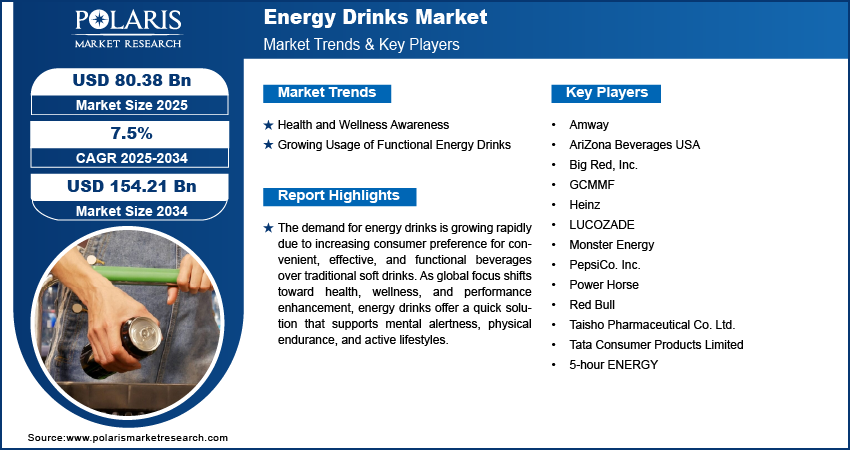Energy Drinks Market is anticipated to grow to USD 154.21 billion by 2034, expanding at a CAGR of 7.5%.

The global energy drinks market size was USD 75.28 billion in 2024, registering a CAGR of 7.5% during 2025–2034.
Market Trends & Insights:
- Shift Toward Natural & Clean Label Products:
Consumers are increasingly opting for energy drinks made with natural caffeine sources, organic ingredients, and reduced or no artificial additives. - Functional & Hybrid Beverages on the Rise:
Energy drinks are being blended with immunity boosters, adaptogens, and hydration components to offer multi-functional health benefits. - Expansion in Demographics:
While previously targeting young males, brands are now expanding to broader groups including women, older adults, and health-conscious consumers. - Sugar-Free & Low-Calorie Innovations:
Growing health awareness has prompted the rise of sugar-free, low-carb, and low-calorie variants of energy drinks. - Sustainable & Smart Packaging:
Eco-friendly packaging and portable, resealable formats are trending, aligning with both environmental concerns and on-the-go consumption habits.
Market Size & Forecast
Market size value in 2025 USD – 80.38 Billion
Revenue forecast in 2034 USD – 154.21 Billion
CAGR – 7.5% from 2025 to 2034
Request for Free Sample:
https://www.polarismarketresearch.com/industry-analysis/energy-drink-market/request-for-sample
Market Overview:
The Energy Drinks Market is experiencing robust growth fueled by changing lifestyles, increasing urbanization, and rising demand for functional beverages. These drinks, typically containing caffeine, taurine, vitamins, and other performance-boosting ingredients, are popular among millennials, athletes, working professionals, and students seeking quick energy boosts, enhanced focus, and stamina.
Market Growth Drivers:
- Rising Demand for On-the-Go Functional Beverages:
Busy, fast-paced lifestyles are pushing consumers toward convenient, ready-to-drink energy beverages that offer instant refreshment and alertness. - Increasing Popularity in Sports & Fitness:
Athletes and fitness enthusiasts are turning to energy drinks for pre-workout boosts and recovery, driving growth in the sports nutrition segment. - Urbanization & Westernization of Diets:
In emerging economies, urban populations are adopting Western-style diets and beverages, including energy drinks. - Aggressive Marketing and Branding Strategies:
Strategic sponsorships in sports, music festivals, and eSports are expanding brand visibility and consumer engagement. - Growth of E-commerce & D2C Channels:
Online availability, subscription models, and influencer-led promotions are enhancing product accessibility and brand loyalty.
Energy Drinks Market Challenges:
- Health Concerns Over High Caffeine & Sugar Content:
Rising awareness of potential adverse effects—such as cardiovascular risks and sleep disturbances—may restrict consumption among health-sensitive groups. - Regulatory Scrutiny and Labeling Norms:
Regulatory authorities in various countries are tightening norms around labeling, ingredient usage, and caffeine limits, posing compliance challenges. - Intense Competition and Market Saturation:
With numerous brands offering similar products, differentiation and consumer retention have become difficult in mature markets. - Price Sensitivity in Emerging Economies:
High product prices in developing regions may limit adoption, especially among price-sensitive consumers. - Misinformation & Public Perception Issues:
Misunderstandings regarding energy drink safety and media reports of misuse may negatively impact consumer trust.






